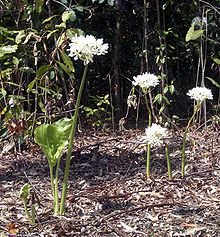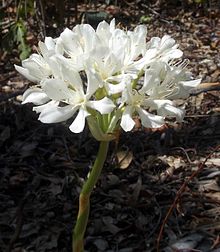| Cardwell lily | |
|---|---|

| |
| In Cooktown, Queensland | |
| Scientific classification | |
| Kingdom: | Plantae |
| Clade: | Tracheophytes |
| Clade: | Angiosperms |
| Clade: | Monocots |
| Order: | Asparagales |
| Family: | Amaryllidaceae |
| Subfamily: | Amaryllidoideae |
| Genus: | Proiphys |
| Species: | P. amboinensis |
| Binomial name | |
| Proiphys amboinensis (L.) Herb. | |
| Synonyms | |
List
| |
Proiphys amboinensis is the type species of the flowering plant genus Proiphys. Its common names include Cardwell lily and northern Christmas lily (as it usually flowers around Christmas). It is considered native to Thailand, Indonesia (Maluku, Sulawesi, Bali, Lombok, Timor), the Philippines, the Bismark Archipelago, Vanuatu, New Guinea and Australia (Queensland and Western Australia). It is also naturalized in Seychelles, Sri Lanka, Solomon Islands, Niue, Society Islands, Caroline Islands and Mariana Islands.
Taxonomy
Its species epithet amboinensis was named after the island of Ambonia, now Ambon in Indonesia.
Description
The Caldwell lily grows on seashores and rocky places up to an altitude of 500 metres. It prefers open, lightly shaded rainforests. It grows from a bulb measuring up to 8 centimetres in diameter; it grows quickly after the arrival of the wet season in Australia. Its leaves are ovate and nearly circular measuring 20–30 cm long and 15–35 cm wide from stalks between 15 and 60 centimetres long. The leaves die away in the dry season.
Umbel

A total of 5–25 white flowers grow in an umbel on stalks over between 15 and 90 cm long, each flower is trumpet shaped and release a pleasant scent with filaments 2–3 mm long. Flowering in Australia typically begins in late December while flowering season in India is from May to June.
Fruit produced from pollination are green to blackish capsules 25–30 mm across.
Cultivation and uses
It is a good container plant that needs much water in the growing season. Propagate from seed or lift the bulb.
References
- ^ "Proiphys amboinensis". Plants of the World Online. Royal Botanic Gardens, Kew. Retrieved 22 October 2023.
- ^ Linnaeus, Carl von (1753). "Pancratium amboinense". Species Plantarum. Vol. 1. p. 291 – via Biodiversity Heritage Library.
- Rafinesque, Constantine Samuel (1833). Stemonix nervosus=. Philadelphia, Pennsylvania, USA: Atlantic Journal, and Friend of Knowledge. p. 165.
- ^ Geernick, D. J. L. (1993). "Amaryllidaceae". Flora Malesiana. 11 (2): 353–373 – via Naturalis Institutional Repository.
- "Proiphys amboinensis". Australian Tropical Rainforest Plants. Retrieved 22 October 2023.
- Mullins, Effie (2012). "The genus Proiphys". Growing Native Plants. Australian National Botanic Gardens and Centre for Australian National Biodiversity Research. Retrieved 7 April 2015.
- Fay, Michael F.; Chase, Mark W. (1996). "Resurrection of Themidaceae for the Brodiaea alliance, and Recircumscription of Alliaceae, Amaryllidaceae and Agapanthoideae". Taxon. 45 (3): 441–451. doi:10.2307/1224136. JSTOR 1224136.
- ^ Scarth-Johnson, Vera (2000). National Treasures: Flowering Plants of Cooktown and Northern Australia. Vera Scarth-Johnson Gallery Association. ISBN 0-646-39726-5.
- ^ "Proiphys amboinensis (L.) Herb". Atlas of Living Australia. National Research Infrastructure of Australia. Archived from the original on 4 March 2016. Retrieved 7 April 2015.
- Beasley, John. 2006. Plants of Tropical North Queensland: the Compact Guide. Footloose Publications, Kuranda. ISBN 1-876617-13-6.
- Herbert, William. 1821. Appendix 42, Proiphys amboinensis
| Taxon identifiers | |
|---|---|
| Proiphys amboinensis |
|
| Pancratium amboinense | |